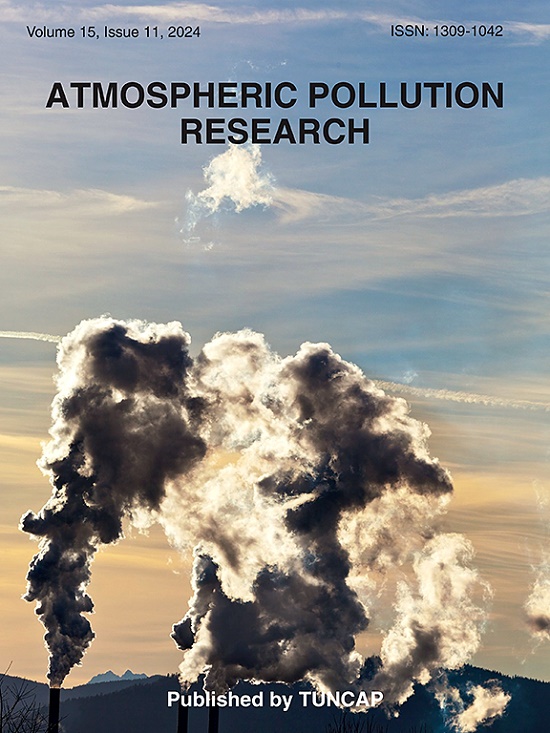炼油厂-石化联合企业挥发性有机化合物源剖面和动态排放清单研究
IF 3.9
3区 环境科学与生态学
Q2 ENVIRONMENTAL SCIENCES
引用次数: 0
摘要
由于复杂的生产工艺和大量的逃逸性排放,炼油石化联合企业(IRPC)的挥发性有机化合物(VOCs)排放难以量化。以往的研究主要集中在炼油厂的上游装置,对整个综合炼油石化联合企业的综合排放因子 (EF) 和清单的研究十分有限。我们分析了 IRPC 内部的多个排放源,包括设备泄漏 (EL)、固定燃烧 (SC)、冷却塔 (CT)、储罐 (ST)、废水收集和处理系统 (WT)、工艺通风口 (PV)、火炬 (F) 和装载操作 (LO)。IRPC 的环境因子为 0.21 kg VOCs/t(原油加工量)。此外,为了减少与传统排放清单相关的时滞,我们开发了 IRPC 中 VOCs 排放的动态核算方法。这些方法整合了监测数据和时变气象参数(如温度、气压、风速),以估算 SC 和 ST 的排放量。采用气相色谱-质谱(GC-MS)和火焰离子化检测(FID)相结合的综合分析系统对 115 种挥发性有机化合物进行定性和定量。采用加权平均法从 18 个单位的 35 个地点收集了综合源剖面采样。与只关注上游单元的研究相比,这种详细的细分提供了更全面的 IRPC 排放情况。在 IRPC 中,确定的主要污染物包括丙烷、乙烷、丙酮、乙醇、丙烯和二氯甲烷。烯烃和炔烃的臭氧形成潜能值(OFP)最高,而芳烃的二次有机气溶胶形成潜能值(SOAP)最高。该研究的详细来源概况和动态排放清单有助于石化污染控制和区域空气质量改善。本文章由计算机程序翻译,如有差异,请以英文原文为准。

Study on volatile organic compound source profiles and dynamic emission inventories in an integrated refinery-petrochemical complex
Volatile organic compound (VOCs) emissions from integrated refinery-petrochemical complex (IRPC) were difficult to quantify due to complex production processes and significant fugitive emissions. Previous studies had largely focused on upstream refinery units, with limited research on comprehensive emission factors (EFs) and inventories for the entire IRPC. We analyzed multiple emission sources within IRPC, including equipment leaks (EL), stationary combustion (SC), cooling towers (CT), storage tanks (ST), wastewater collection and treatment systems (WT), process vents (PV), flares (F), and loading operations (LO). The EFs of IRPC was 0.21 kg VOCs/t of crude processed. Additionally, to mitigate the temporal lag associated with traditional emission inventories, we developed dynamic accounting methods for VOCs emissions in IRPC. These methods integrate monitoring data and time-varying meteorological parameters (e.g., temperature, air pressure, wind speed) to estimate emissions from SC and ST. An integrated analytical system combining gas chromatography-mass spectrometry (GC-MS) and flame ionization detection (FID) was used to characterize and quantify 115 VOCs species. Composite source profiles were sampling from 35 sites collected across 18 units using a weighted average method. This detailed breakdown provided a more comprehensive view of IRPC emissions compared to studies focusing solely on upstream units. In the IRPC, key pollutants identified include propane, ethane, acetone, ethanol, propylene, and dichloromethane. Alkenes and alkynes had the highest ozone formation potential (OFP) contribution, while aromatics had the greatest secondary organic aerosol formation potential (SOAP) contribution. The study's detailed source profiles and dynamic emission inventory aid petrochemical pollution control and regional air quality improvements.
求助全文
通过发布文献求助,成功后即可免费获取论文全文。
去求助
来源期刊

Atmospheric Pollution Research
ENVIRONMENTAL SCIENCES-
CiteScore
8.30
自引率
6.70%
发文量
256
审稿时长
36 days
期刊介绍:
Atmospheric Pollution Research (APR) is an international journal designed for the publication of articles on air pollution. Papers should present novel experimental results, theory and modeling of air pollution on local, regional, or global scales. Areas covered are research on inorganic, organic, and persistent organic air pollutants, air quality monitoring, air quality management, atmospheric dispersion and transport, air-surface (soil, water, and vegetation) exchange of pollutants, dry and wet deposition, indoor air quality, exposure assessment, health effects, satellite measurements, natural emissions, atmospheric chemistry, greenhouse gases, and effects on climate change.
 求助内容:
求助内容: 应助结果提醒方式:
应助结果提醒方式:


